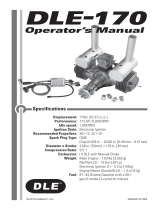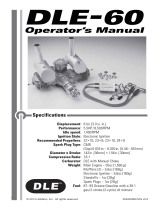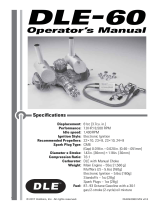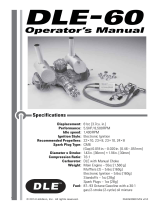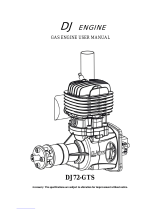
3
●
For your safety and the safety of others, please do not stand in
front or in line with the propeller when the engine is running. Keep
onlookers away from the running engine, especially small children.
●
Always use a balanced spinner and a balanced propeller. An
unbalanced spinner and propeller combination will cause high levels
of vibration and may cause the propeller shaft to break. Always
use a lightweight spinner on your engine. Lightweight spinners
are considered to be those with a cone wall of 1mm or less. Heavy
spinners could cause the propeller shaft to break. Securely tighten
the spinner and propeller on the engine to prevent them from being
thrown off the engine while running.
●
Never use a propeller that has hit the ground. Even though it may
look good from the outside, it may be cracked on the inside which
may cause it to disintegrate while in use. Do not use a nicked,
cracked or split propeller.
●
Keep foreign objects away from the propeller. Make sure that
nothing can be “sucked in” by the propeller.
●
Never start the engine on loose gravel or sand.
●
Do not attempt to stop the engine by throwing anything into the
path of the propeller.
●
Make sure the fuel line is well-secured to the engine and to the
fuel tank so that it won’t come off in fl ight.
●
Do not use silicone fuel line because it will be dissolved by the fuel.
Use gasoline approved rubber fuel line. Always secure the fuel
line away from the cylinder head. The engine’s heat can damage
the fuel line.
●
Never touch the engine immediately after a run. The engine will
be hot.
●
Before transporting your model, remove all the fuel from the fuel
tank and fuel lines.
● Always use high-quality oil intended for 2-stroke (2-cycle) engines.
It’s a good idea to use a petroleum-based 2-cycle motor oil like
Lawn Boy All Season - Ashless oil for the break-in period.
●
The throttle and choke pushrods should be non-metallic.
●
If the engine is not to be used for more than a month, drain the
fuel tank and remove any fuel from inside the carburetor. Do this
by running the engine at idle until it quits by running out of fuel.
Keeping gasoline inside the carburetor over an extended period of
time will damage the diaphragm valve and clog passages inside
the carburetor. Due to the carburetor being more complicated
than those used in glow engines, keep the fuel clean by using a
fuel fi lter. Use a fi lter intended to be used with gasoline engines.
Metal fi lters intended for glow engines are too coarse and will not
screen out fi ner particles.
























